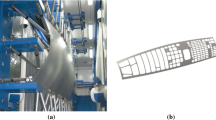Abstract
This paper deals with the reconstruction of three-dimensional (3D) geometric shapes based on observed noisy 3D measurements and multiple coupled nonlinear shape constraints. Here a shape could be a complete object, a portion of an object, a part of a building etc. The paper suggests a general incremental framework whereby constraints can be added and integrated in the model reconstruction process, resulting in an optimal trade-off between minimization of the shape fitting error and the constraint tolerances. After defining sets of main constraints for objects containing planar and quadric surfaces, the paper shows that our scheme is well behaved and the approach is valid through application on different real parts. This work is the first to give such a large framework for the integration of numerical geometric relationships in object modeling from range data. The technique is expected to have a great impact in reverse engineering applications and manufactured object modeling where the majority of parts are designed with intended feature relationships.
Similar content being viewed by others
References
Anderl, R., & Mendegen, R. (1996). Modelling with constraints: Theoretical foundation and application. CAD, 28(3): 155–168.
Bolle, R. M., & Cooper, D. B. (1986). On optimally combining pieces ofinf ormation, with application to estimating 3-D complex-object position from range data. IEEE Trans. PAMI, 8(5): 619–638.
Broyden, C. G., & Attia, N. F. (1988). Penalty functions, Newton's method and quadratic programming. Journal of Optimization Theory and Applications, 58(3): 377–385.
De Geeter, J., Brussel, H. V., De Schutter, J., & Decreton, M. (1997). A smoothly constrained Kalman filter. IEEE Trans. PAMI, 19(10): 1171–1177.
Feng, C.-X., & Kusiak, A. (1995). Constraints-based design ofparts. CAD, 27(5): 343–352.
Fiacco, A. V., & McCormick, G. P. (1968). Nonlinear Programming: Sequential Unconstrained Minimization Techniques. John Wiley & Sons, New York.
Fitzgibbon, A. F., Eggert, D. W., & Fisher, R. B. (1997). High-level CAD model acquisition from range images. CAD, 29(4): 321–330.
Fletcher, R. (1987). Practical Methods of Optimization. John Wiley & Sons.
Gill, P. E., Murray, W., & Wright, M. H. (1981). Practical Optimization. Academic Press.
Goldberg, D. E. (1989). Genetic Algorithms in Search, Optimization and Machine Learning. Addison-Wesley, Reading, MA.
Hoover, A., Jean-Baptiste, G., Jiang, X., Flynn, P. J., Bunke, H., Goldgof, D., Bowyer, K., Eggert, D., Fitzgibbon, A., & Fisher, R. (1996). An experimental comparison ofrange segmentation algorithms. IEEE Trans. PAMI, 18(7): 673–689.
Jacoby, S. L. S., Kowalik, J. S., & Pizzo, J. T. (1972). Iterative Methods for Nonlinear Optimization Problems. Prentice-Hall, Inc., Englewood Cliffs, New Jersey.
Michalewicz, Z. (1996). Genetic Algorithms + Data Structures = Evolution Programs. Springer-Verlag.
Murray, W. (1969). An algorithm for constrained minimization. In Fletcher, R. ed., Optimization, pages 247–258. Academic press, London.
Porrill, J. (1988). Optimal combination and constraints for geometrical sensor data. International Journal of Robotics Research, 7(6): 66–78.
Requicha, A. A. G. (1984). Representation oftolerances in solid modeling: Issues and alternative approaches. In Boyse, J. W., & Pickett, M. S., eds., Solid Modelling by Computers: From Theory to Applications, New York: Plenum, pages 3–22.
Rockafellar, R. T. (1970). Convex Analysis. Princeton University Press.
Rockwood, A. P., & Winget, J. (1997). Three-dimensional object reconstruction from two-dimensional images. CAD, 29(4): 279–286.
Shin, B. S., & Shin, Y. G. Fast 3D solid model reconstruction from orthographic views. CAD, 30(1): 63–76.
Varady, T., Martin, R. R., & Cox, J. (1997). Reverse engineering ofgeometric models, an introduction. CAD, 29(4): 255–268.
Werghi, N., Fisher, R. B., Ashbrook, A., & Robertson, C. (1998). Modelling objects having quadric surfaces incorporating geometric constraint. In Proceedings of the ECCV'98, pages 185–201, Freiburg, Germany.
Yan, Q. W., Chen, C. L. P., & Tang, Z. (1994). Reconstruction of3D objects from orthographic projections. CAD, 26(9).
Author information
Authors and Affiliations
Rights and permissions
About this article
Cite this article
Werghi, N., Fisher, R., Ashbrook, A. et al. Shape Reconstruction Incorporating Multiple Nonlinear Geometric Constraints. Constraints 7, 117–149 (2002). https://doi.org/10.1023/A:1015105531094
Issue Date:
DOI: https://doi.org/10.1023/A:1015105531094




